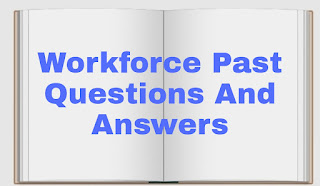Workforce Past Questions And Answers
Here are workforce-related questions along with multiple-choice options and suggested answers:
Which of the following is NOT a common employee benefits program?
a) Health insurance
b) Retirement plan
c) Paid time off
d) Stock options
Answer: d) Stock options
What is the purpose of a performance appraisal?
a) Determine employee promotions
b) Identify areas of improvement
c) Assess training needs
d) All of the above
Answer: d) All of the above
Which factor is most likely to contribute to employee job satisfaction?
a) Competitive salary
b) Challenging work
c) Recognition and rewards
d) Work-life balance
Answer: d) Work-life balance
What does the term "diversity" refer to in the workplace?
a) Variation in employee ages
b) Different job roles within an organization
c) Differences in employee backgrounds and characteristics
d) Number of employees in an organization
Answer: c) Differences in employee backgrounds and characteristics
What is the purpose of onboarding for new employees?
a) Introduce them to the company culture
b) Provide necessary training
c) Facilitate integration into the team
d) All of the above
Answer: d) All of the above
What is the primary goal of employee engagement initiatives?
a) Increase employee productivity
b) Improve employee satisfaction
c) Foster a positive work environment
d) All of the above
Answer: d) All of the above
What is the significance of a SWOT analysis in workforce planning?
a) Identifying employee strengths and weaknesses
b) Assessing external opportunities and threats
c) Developing strategies for talent acquisition and retention
d) All of the above
Answer: d) All of the above
What is the difference between a leader and a manager?
a) Leaders focus on vision and inspiration, while managers focus on execution
b) Leaders have formal authority, while managers have informal influence
c) Leaders handle long-term goals, while managers handle short-term tasks
d) Leaders make decisions, while managers delegate tasks
Answer: a) Leaders focus on vision and inspiration, while managers focus on execution
What is the purpose of a job analysis?
a) Determine an employee's eligibility for promotion
b) Identify the knowledge, skills, and abilities required for a specific job
c) Determine employee compensation
d) Assess employee performance
Answer: b) Identify the knowledge, skills, and abilities required for a specific job
What is the significance of succession planning in an organization?
a) Identifying and developing future leaders
b) Determining employee salaries
c) Evaluating employee job performance
d) Improving employee morale
Answer: a) Identifying and developing future leaders
Which of the following is NOT an example of a non-monetary reward?
a) Recognition and praise
b) Flexible work hours
c) Performance bonuses
d) Opportunities for career development
Answer: c) Performance bonuses
How can organizations promote diversity and inclusion?
a) Implementing diversity training programs
b) Creating a diverse and inclusive recruitment strategy
c) Establishing employee resource groups
d) All of the above
Answer: d) All of the above
What is the purpose of a 360-degree feedback process?
a) Evaluating employee performance from multiple perspectives
b) Identifying areas for improvement and development
c) Strengthening communication and collaboration within teams
d) All of the above
Answer: d) All of the above
What is the role of HR in talent acquisition?
a) Developing job descriptions and posting job ads
b) Conducting interviews and selecting candidates
c) Negotiating job offers and compensation packages
d) All of the above
Answer: d) All of the above
How can organizations promote employee learning and development?
a) Providing training programs and workshops
b) Offering tuition reimbursement for further education
c) Encouraging employees to attend conferences and seminars
d) All of the above
Answer: d) All of the above
What is the importance of employee retention strategies?
a) Reducing recruitment and training costs
b) Maintaining organizational knowledge and expertise
c) Fostering a stable and productive work environment
d) All of the above
Answer: d) All of the above
What are the benefits of promoting work-life balance for employees?
a) Increased job satisfaction and productivity
b) Improved mental and physical well-being
c) Reduced absenteeism and turnover rates
d) All of the above
Answer: d) All of the above
How can organizations assess employee satisfaction and engagement?
a) Conducting employee surveys
b) Holding regular one-on-one meetings with managers
c) Monitoring employee turnover and retention rates
d) All of the above
Answer: d) All of the above
What is the purpose of a disciplinary process in the workplace?
a) Addressing employee misconduct and performance issues
b) Encouraging continuous improvement and behavior correction
c) Ensuring a fair and consistent approach to handling issues
d) All of the above
Answer: d) All of the above
How can organizations promote a culture of innovation?
a) Encouraging employee creativity and idea generation
b) Providing resources and support for experimentation
c) Recognizing and rewarding innovative contributions
d) All of the above
Answer: d) All of the above.

Post a Comment